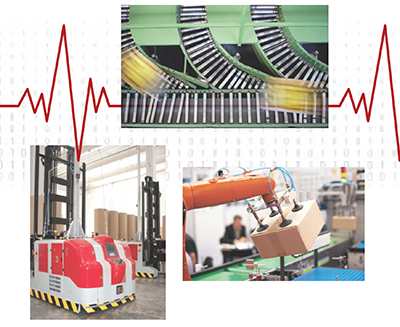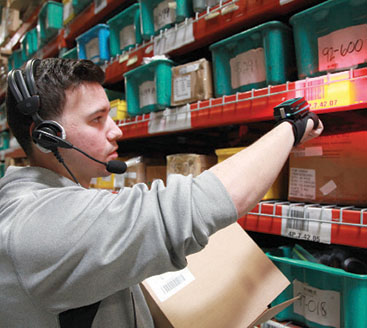Automation: What’s at the heart of your system?
While automated equipment at today’s warehouses can be at the heart of their success, any single piece of automation needs to be balanced with upstream and downstream processes, raising the importance of software to sync the flow of work and ensure the heart of the system keeps ticking.

It’s tempting to copy the choices of distribution centers that have broken through to higher productivity after deploying automated materials handling. The pages of Modern are filled with examples of companies that have tapped solutions like mini-load shuttles, voice picking or goods-to-person robotics to achieve greater speed, labor savings and accuracy.
So, why not just install some of that equipment at your DC and wait for similarly dramatic benefits? The short answer, say consultants involved with warehouse automation, is that replicating the path taken at another DC may turn out to be disappointing if the automation installed doesn’t support core goals or match the nuances of your facility’s order profile.
“Copying what another facility has done can be the worst way to approach a project because it’s the tail wagging the dog,” says Chris Castaldi, vice president of sales for DMW&H, a warehouse consulting and systems integration firm. “You have to back up and really understand the nuances of a company’s business and customer service requirements, and then from there, think about the tenets that will drive the systems and processes you should put in.”
DMW&H clients such as REI, the outdoor goods retailer, have had success with specific types of automation, notes Castaldi, but he believes the key to REI’s success was keeping core operational goals in mind as they selected methods and equipment.
 Other consultants concur that deciding which automated systems should drive productivity—in effect determining what should be at the heart of your DC—goes well beyond an equipment capability focus. It starts with analysis of the order profile and throughput requirements, with close attention to stock keeping unit (SKU) characteristics such as products that are non-conveyable or difficult to bar code.
Other consultants concur that deciding which automated systems should drive productivity—in effect determining what should be at the heart of your DC—goes well beyond an equipment capability focus. It starts with analysis of the order profile and throughput requirements, with close attention to stock keeping unit (SKU) characteristics such as products that are non-conveyable or difficult to bar code.
But DC projects also increasingly must address omni-channel requirements such as more each picking and tighter cycle times. These e-commerce pressures are driving a need for warehouse control system (WCS) solutions, also known as warehouse execution system (WES) solutions, to orchestrate a DC’s automation and balance the flow of work to crank more orders through a facility in less time.
Follow priorities
When REI came up with the systems for its new warehouse in Goodyear, Ariz., it followed a set of core goals or “tenets” that centered around sustainability and connection with the REI brand. As part of these tenets, REI wanted an order fulfillment method that was simple and efficient, and that would streamline the number of touches needed to pick orders for stores or e-commerce. These goals, says Castaldi, coalesced around REI’s concept of one-touch production and eventually led to a system that combines an automated shuttle with pocket sortation to create workstations for omni-channel fulfillment.
At these workstations, for store orders, associates pick items to cartons; and for direct-to-consumer e-commerce orders, they pick to pockets in a pocket sorter. Pick-to-light displays in the workstations instruct the workers, while photo eye sensors catch misplacements. The system works well for REI, says Castaldi, because it constantly is filling store orders. DMW&H’s WCS solution is used to match incoming e-commerce orders with store replenishment orders so that if a tote with the needed SKU is headed to a workstation, the e-commerce order can be picked concurrently with the store order.
“The driving idea was that one person can be filling retail orders while at the same time filling direct-to-consumer orders,” says Castaldi. 
And while the facility employs specific automated equipment to speed up and simplify picking, Castaldi adds, much of the success of the overall system is in how the automated solutions are combined, and how the WCS software dynamically assigns orders to the right totes and workstations. “We were tasked with making the DC super efficient,” says Castaldi. “That efficiency is driven by software, or the ‘brains’ for the automated systems, which can be seen as the heart or muscles of the DC,” says Castaldi. “If you want to be multi-tasking, which is what an omni-channel DC is all about, you need a smart brain.”
The use of totes holding a single SKU, light-based picking instructions, and simplicity of the pocket sortation procedure ensures high order accuracy without having to build in extra bar code labeling or data collection procedures, says Castaldi. For DCs that often deal with small items or products like bagged garments where the bar code label isn’t in a reliably readable position, bar code validation can create extra labeling and data collection work.
“The combination of shuttle and pocket sortation technology fit the nuances of what REI was trying to accomplish, which was to make things simple and accurate without creating extra steps,” Castaldi says. “The starting point was ensuring the best possible customer experience, and from there, we looked at the best options that would allow us to streamline the fulfillment processes. It’s important to keep your core goals in mind, and then see which options best align with those goals.”
Breaking constraints
DC projects have always started with careful analysis of order profiles, SKU characteristics and throughput targets, notes Carlos Ysasi, vice president of engineering for VARGO, a warehouse systems integrator and WES provider. “It all starts with the order profile, and what that is telling you,” he says. “Then, you must consider the throughput that DC is going to need to achieve and start looking at the processing engine or automation you need to have in place to achieve that type of throughput. We break that down by the output by the hour and begin looking at what can actually handle that throughput.”
VARGO served as an integrator and WES solution provider for American Eagle’s omni-channel DC in Hazle Township, Pa. In that project, says Ysasi, the throughput requirement was 20,000 units per hour, which drove the need for some automated machinery.
The systems in use at the DC include an inbound conveyor and sortation system that routes incoming goods directly to where they are needed most—either for store orders or direct-to-consumer orders—and a large unit sorter and put walls for picking, as well as other picking methods, including ring scanners. Coordinating the various automated systems is VARGO’s WES.
While specific types of automation may be needed to meet particular throughput goals, a good WES serves to ensure a smooth flow between the various solutions, says Ysasi, making decisions in near real time based on demand at the time. “WES is making all of these decisions and driving the flow of production through the building so we don’t overwhelm a process, starve a process for work, or so we don’t have to buffer in between processes,” he says.
Art Eldred, VARGO client executive for systems engineering, adds that as omni-channel fulfillment has become a reality for more DCs, it has tightened order cycle times to such an extent that WES is needed to continuously match orders and work to the DC’s resources and coordinate the flow of work between automated systems. While warehouse management system (WMS) solutions that batch work together in planned increments, or waves, tend to work well for more manual facilities doing traditional store fulfillment, they aren’t dynamic or real time enough to serve as the brains for a highly automated omni-channel facility, says Eldred.
“Today, WES as the brains to make things come in and out of the automation becomes more important,” says Eldred. “Driving down order cycle time and flow have become the top things to focus on, while efficiency, though still important, is becoming secondary. That’s a change from where we were in the past.” Ysasi also sees a change in DC methods where omni-channel fulfillment centers want to get product moved quickly from receiving to the active picking environment without the extra touches involved in building pallets; storing pallets to a reserve storage area; and moving goods once again from reserve to a ready reserve or pick area.
With WES software, it’s possible to quickly make decisions on where inbound cases of goods are needed most, and route them straight to the optimal picking area, thereby speeding up the overall flow, says Ysasi. “When you have fulfillment centers with all active inventory, where basically every piece is available at any possible time to get picked, packed and shipped, you’ve just opened yourself up really decreasing cycle time,” he says.
Think lean
Some DCs may rely heavily on a major piece of automation to attain a pick rate, but for most DCs, the key to throughput is balance between pick, pack and ship operations, says Dan Hanrahan, CEO of The Numina Group. “I look at order fulfillment as a three-legged stool of picking, packing and shipping,” he says. “If any one of those areas gets out of alignment with the others, it causes problems.”
For example, says Hanrahan, if a DC adopts voice picking and ramps up the number of orders picked per hour, but has no pack automation in place, a bottleneck can easily occur at its pack stations. The better approach, says Hanrahan, is to look at ways to balance the flow of work through the overall system, rather than trying to accelerate just one area. One streamlining step could be to voice pick directly to cartons—using cartonization logic to select the proper cartons—rather than picking to a tote and sending the tote to a pack station. “You essentially are combining two main tasks when you do that,” says Hanrahan.
WES/WCS software not only orchestrates that different automation along the same material flow, says Hanrahan, but also can manage parallel processes so order elements that use different machinery all get to outbound shipping at the right time. An example of this would be oversized items that are non-conveyable, but need to be shipped concurrently with smaller items going to the same customer. “The software is key—you need good warehouse execution/control software with a sophisticated picking module and wave management logic to allow for parallelism in picking across different zones, and then consolidating,” says Hanrahan.
Ultimately, balance and flow between key areas of the DC work together to achieve fulfillment goals, says Hanrahan. “Your overall process is like an order fulfillment machine, so you need to keep pick, pack and ship processes in balance to ensure orders flow optimally,” he says. Companies mentionedin this article:

Article Topics
Magazine Archive News & Resources
Latest in Materials Handling
Registration open for Pack Expo International 2024 Walmart chooses Swisslog AS/RS and software for third milk processing facility NetLogistik partners with Vuzix subsidiary Moviynt to offer mobility solutions for warehouses Materials Handling Robotics: The new world of heterogeneous robotic integration BSLBATT is looking for new distributors and resellers worldwide Lucas Watson appointed CSO for Körber’s Parcel Logistics business in North America Hyster recognizes Dealers of Distinction for 2023 More Materials HandlingAbout the Author
Subscribe to Materials Handling Magazine

Find out what the world's most innovative companies are doing to improve productivity in their plants and distribution centers.
Start your FREE subscription today.
April 2024 Modern Materials Handling

Latest Resources










